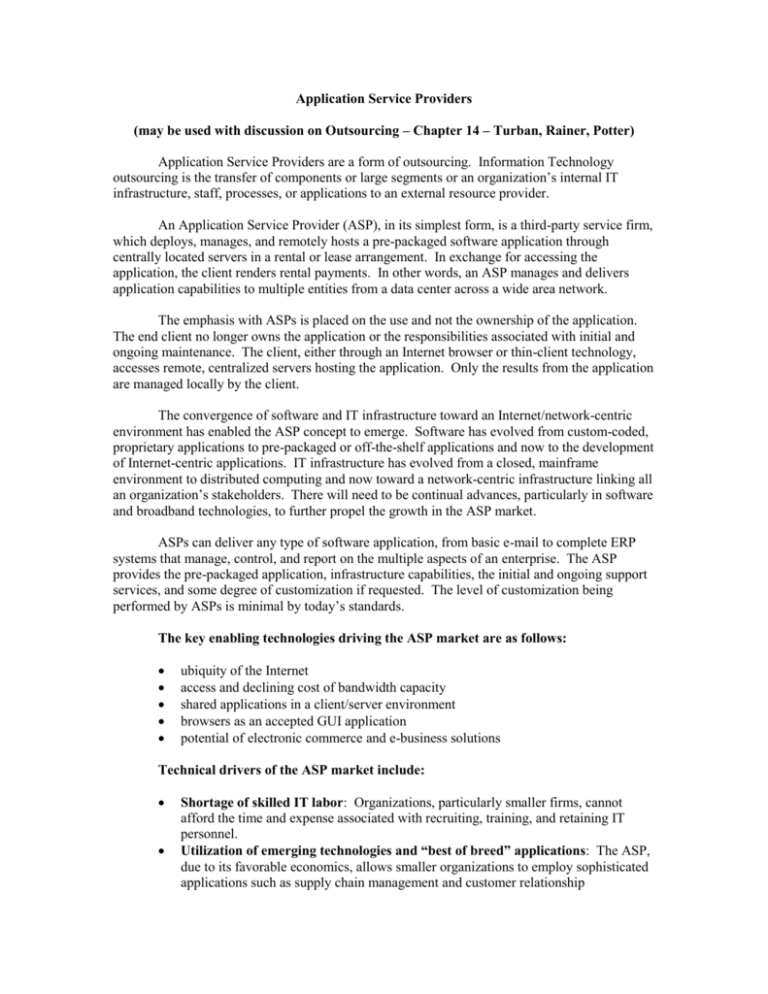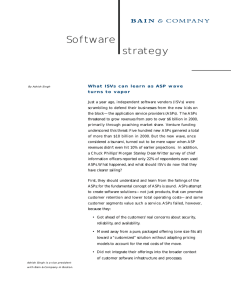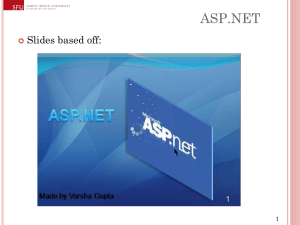Application Service Providers
advertisement

Application Service Providers (may be used with discussion on Outsourcing – Chapter 14 – Turban, Rainer, Potter) Application Service Providers are a form of outsourcing. Information Technology outsourcing is the transfer of components or large segments or an organization’s internal IT infrastructure, staff, processes, or applications to an external resource provider. An Application Service Provider (ASP), in its simplest form, is a third-party service firm, which deploys, manages, and remotely hosts a pre-packaged software application through centrally located servers in a rental or lease arrangement. In exchange for accessing the application, the client renders rental payments. In other words, an ASP manages and delivers application capabilities to multiple entities from a data center across a wide area network. The emphasis with ASPs is placed on the use and not the ownership of the application. The end client no longer owns the application or the responsibilities associated with initial and ongoing maintenance. The client, either through an Internet browser or thin-client technology, accesses remote, centralized servers hosting the application. Only the results from the application are managed locally by the client. The convergence of software and IT infrastructure toward an Internet/network-centric environment has enabled the ASP concept to emerge. Software has evolved from custom-coded, proprietary applications to pre-packaged or off-the-shelf applications and now to the development of Internet-centric applications. IT infrastructure has evolved from a closed, mainframe environment to distributed computing and now toward a network-centric infrastructure linking all an organization’s stakeholders. There will need to be continual advances, particularly in software and broadband technologies, to further propel the growth in the ASP market. ASPs can deliver any type of software application, from basic e-mail to complete ERP systems that manage, control, and report on the multiple aspects of an enterprise. The ASP provides the pre-packaged application, infrastructure capabilities, the initial and ongoing support services, and some degree of customization if requested. The level of customization being performed by ASPs is minimal by today’s standards. The key enabling technologies driving the ASP market are as follows: ubiquity of the Internet access and declining cost of bandwidth capacity shared applications in a client/server environment browsers as an accepted GUI application potential of electronic commerce and e-business solutions Technical drivers of the ASP market include: Shortage of skilled IT labor: Organizations, particularly smaller firms, cannot afford the time and expense associated with recruiting, training, and retaining IT personnel. Utilization of emerging technologies and “best of breed” applications: The ASP, due to its favorable economics, allows smaller organizations to employ sophisticated applications such as supply chain management and customer relationship management. At present, only large companies have been able to deploy these applications. Accelerated application deployment: ASPs can deploy applications much faster than companies could deploy applications in-house. Rapidly changing and increasing complexity of technology: In-house IT departments struggle with the rapid pace of IT development and its increasing complexity. ASPs resolve the internal uncertainty by assuming the application responsibilities and costs. Obtain technical expertise: Many ASPs currently focus on a particular vertical market (or industry group), business function, or application type. This focused approach becomes more valuable to an organization searching for a specific need. Transfer of application ownership risk: Internal IT departments have traditionally been very concerned about the viability and acceptance of an application among its users. These concerns have affected many organizations’ willingness to deploy the next “killer application.” Important business drivers of the ASP market include: Minimize the total cost of ownership (TCO): Using ASPs typically translate into a 30% to 50% annual savings, varying by the complexity of each application. Predictability of cash flows: ASPs introduce a degree of predictability by eliminating the uncertainties of post-implementation software-related expenditures. Focus on core competencies and strategic objectives: The transfer of the implementation and management of an application to a third party enables the organization to focus on developing its core competencies. Improve efficiency of internal IT staff: The elimination of application management enables the internal IT staff the freedom to develop processes and systems to leverage core competencies. Improve coordination efforts on a global basis: ASPs can equip organizations with the latest technical tools and systems necessary to coordinate internal and external global operations. Barriers to the ASP concept: Security of information: One of the central challenges to the ASP concept is the uncertainty regarding trhe security of proprietary information. Organizations will generally be very apprehensive about jeopardizing sensitive information in application hosting arrangements. Overall quality of service and support: Some of the ASP performance concerns include issues of availability, scalability, bandwidth capacity, and data and network redundancy. Service level agreements are contractual agreements binding the ASP to a predetermined level of service and performance. These agreements obligate performance standards and measurements. An ASP’s quality of service will be evaluated b the ability to ensure no single point of failure, a capability to accommodate increasing network traffic spikes, and the perception that the system is locally based. Scope and flexibility of services: There is a tradeoff between scope and flexibility for ASPs. These demands require both front- and back-end expertise from an ASP, including general expertise in the application, a solid understanding of the implementation, and a knowledge base regarding infrastructure requirements. This challenge is further complicated by the notion that organizations will require an ASP to be flexible to meet their unique demands. The issue becomes whether the ASP or the application has the unique characteristics and flexibility to accommodate for all and changing demands. Adaptability of software: Most software today is not truly web-enabled. To be most efficient, existing software applications need to evolve toward a true Internetcentric model that is capable of leveraging the Internet by greatly increasing accessibility, gathering information from multiple destinations, and reducing maintenance demands.











